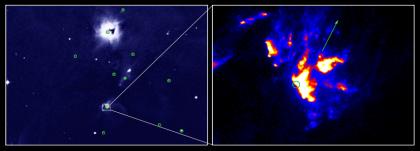Shocking Outflow from a Young Star
The image on the left is a Palomar Digital Sky Survey image of the region of the Orion Nebula that contains Herbig-Haro objects known as HH1 and HH2. The inset (right) presents a zoom that shows the position of the X-ray source (green circle) detected by Chandra in HH2, superimposed on a false-color optical image from the Hubble Space Telescope. Herbig-Haro objects (HH) are clouds of dust and gas that are either part of high-speed jets of gas streaming away from very young stars, or clouds of gas that have been hit by such jets.
The detection of X-rays from HH2 implies that a 600,000 miles per hour jet is plowing into a slower moving cloud. The resulting shock wave heats gas to a million degrees Celsius. The young star producing the jet is heavily obscured and detectable only with infrared and radio telescopes. In the image on the left, it lies about halfway between HH2 and HH1, the small bright cloud above and to the right of HH2.
|
||||||||||||||||||||||||
The astronomical image shows two panels and features two Herbig-Haro objects, HH1 and HH2, which are nebulae in the Orion constellation. Herbig-Haro (HH) objects are young stars that are still in the process of formation. They are named after their discoverers, George Herbig and Guillermo Haro. The colors in the image are predominantly blues, with some orange and yellow highlights. The image on the left is a Palomar Digital Sky Survey optical image of the region showing both HH1 and HH2. The panel on the right presents a zoomed-in version that shows the position of the X-ray source (circled in green) detected by Chandra in HH2, combined with an optical image from the Hubble Space Telescope. The Herbig-Haro objects are clouds of dust and gas that are either part of high-speed jets of gas streaming away from very young stars, or clouds of gas that have been hit by such jets.





